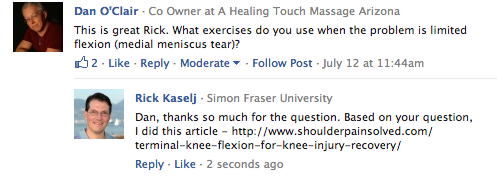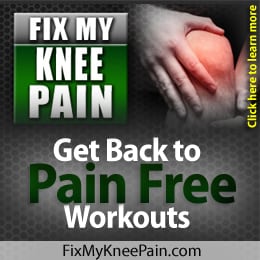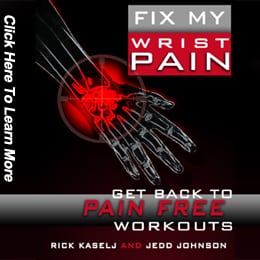Terminal Knee Flexion for Knee Injury Recovery
Today, I wanted to go through the importance of doing Terminal Knee Flexion for overcoming your knee injury.
It is based on a SPS reader question.

In a previous video and article, I talked about the importance of Terminal Knee Extension. Today I wanted to talk about the importance of doing the exact opposite, which is Terminal Knee Flexion.
Example of a Terminal Knee Flexion Exercise
CLICK HERE for the direct link to the video.
In the above video, I go through an example of an exercise that you can do for terminal knee flexion.
How to do the Terminal Knee Flexion Exercise?
I start by standing then move to a wall or something stable and put my hand on it. This will eliminate balance because the focus of this exercise is not balance, but knee range of motion.
I’m going to shift my weight onto one leg (left) and I’m going to grab my right shin or ankle with my right hand. I am going to use my right hand to pull the leg so that my heel ends up hitting my seat. I will hold this end position for a second. Then I am going to let the right leg move back down to the starting position.
KEY POINT ==> I am going to do it again and the key thing is I’m letting that knee pass the hips. I’m not having the knees parallel to the other knee or the knee directly underneath the hip. I am letting that knee go forward and that is important because sometimes tight hip flexors will end up affecting your range of motion of hip flexion. If you have tight hip flexors, it will decrease your knee range of motion and I want to take them out of the exercise so I can focus on just knee movement.
A lot of times with knee pain and injuries, people will have difficulty with terminal knee flexion. They might end up feeling a little discomfort. I am not concerned about screaming pain, I’m looking for a little bit of discomfort and that’s okay. I would end up doing 5 repetitions to start off with and build from there. I’m not going to do 50 repetitions through the discomfort as this will lead to knee pain and a knee flare up.
In the video, you can see the speed that I end up doing the exercise at and I am just working on getting that end range terminal flexion working.
This is an exercise that someone with knee pain or a knee injury should do especially if they have knee osteoarthritis, ACL injury or meniscus tear.
Let’s go through another terminal knee flexion exercise that you can do that is easier than the above one.
Terminal Knee Flexion on the Floor
CLICK HERE for the direct link to the above video
With this terminal knee extension exercise, I wanted to go through one that is a regression (easier or less demanding) from the one that I started this article with.
How to Do the Terminal Knee Extension Exercise on the Floor
In the video above, I am in a kneeling position. You’ll have to decide for yourself if you are able to get into this position. If kneeling bothers your knee because of your knee pain or a knee injury, you can skip this step. You can avoid the kneeling position by just lying on your side on a bed or couch.
Get into a lying position with your legs on a stability ball. Then place the stability ball underneath your heels so that your legs end up being straight.
Looking at the rest of my body, I’ve got my upper body in a good position, in a straight line and relaxed.
And now I am going to use both heels and pull the stability ball towards my seat and then back to the start.
When I pull towards my seat, my knees are going into full flexion or as much as possible.
In the video, I could go a little bit further and this would have been good because it works on hip flexion, which is also a very important movement when it comes to knee injury recovery.
One other thing the stability ball helps is it takes of some of the load off of the knee, which makes the exercise easier.
Let’s go through one more terminal knee flexion exercise. It is a progression (harder or more demanding) from the second one.
Terminal Knee Flexion Exercise on Your Stomach
CLICK HERE to go directly to the video
In this video I also go through another terminal flexion exercise that you can do for your knee injury or knee pain. I am doing this one specifically for the meniscus tear exercise program that I am putting together. It’s part of the injury of the month series.
Performing the Terminal Knee Flexion Exercise on Your Stomach
I am starting off in a kneeling position (please see above on what to do if you have an issue with kneeling).
I am going to get on to my stomach with my legs straight. I can rest my hands against my forehead for comfort while trying to keep the body in a good alignment.
Now I am going to end up moving that right heel towards my seat as far as you can. In the video, you can see that I am not able to bring my heel all the way to my seat.
Now what I am going to do is, with that right heel as far back as possible, I am going to reach back with that right arm and grab just above the ankle and pull that heel to my seat in order to get that end range terminal knee flexion. Then I will bring the hand back to the start and let the leg straighten and return to the starting position.
There you go. Three different terminal knee flexion exercises that you can do for your knee pain or injury.
If you are looking for a resource area for injuries and exercises make sure to swing by exercisesforinjuries.com. You’ll find a whole bunch of information there when it comes to exercises for knee injury and knee pain, plus a couple of great interviews that you can access at no cost.
If you are looking for an injury program for your knee injury, make sure to swing by kneeinjuryexercises.com. There you can see the exercise program that I use for athletes and fit individuals for their knee injury recovery.
One last thing: I am putting the finishing touches on the Meniscus Tear Solution, which is an exercise program for those with a meniscus tear. It will be available next Wednesday.

That is it.
Take care.
Rick Kaselj, MS



